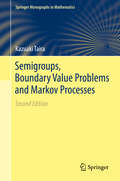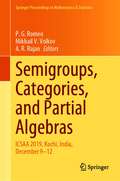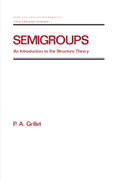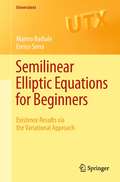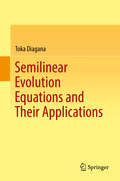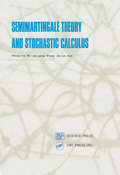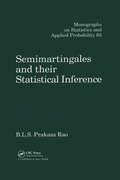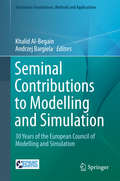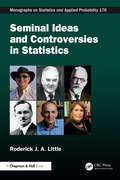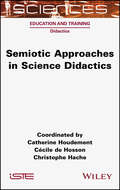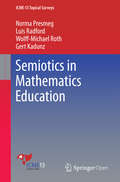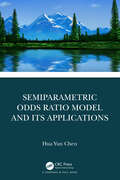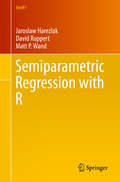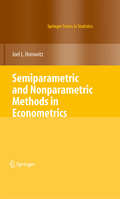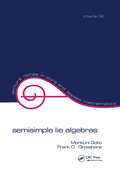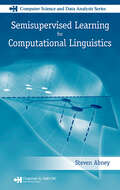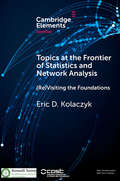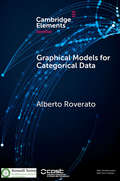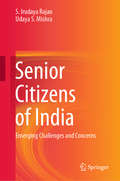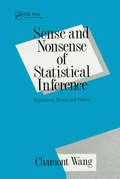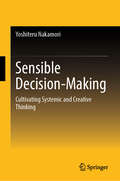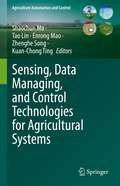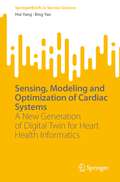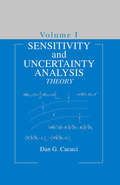- Table View
- List View
Semigroups, Boundary Value Problems and Markov Processes
by Kazuaki TairaA careful and accessible exposition of functional analytic methods in stochastic analysis is provided in this book. It focuses on the interrelationship between three subjects in analysis: Markov processes, semi groups and elliptic boundary value problems. The author studies a general class of elliptic boundary value problems for second-order, Waldenfels integro-differential operators in partial differential equations and proves that this class of elliptic boundary value problems provides a general class of Feller semigroups in functional analysis. As an application, the author constructs a general class of Markov processes in probability in which a Markovian particle moves both by jumps and continuously in the state space until it 'dies' at the time when it reaches the set where the particle is definitely absorbed. Augmenting the 1st edition published in 2004, this edition includes four new chapters and eight re-worked and expanded chapters. It is amply illustrated and all chapters are rounded off with Notes and Comments where bibliographical references are primarily discussed. Thanks to the kind feedback from many readers, some errors in the first edition have been corrected. In order to keep the book up-to-date, new references have been added to the bibliography. Researchers and graduate students interested in PDEs, functional analysis and probability will find this volume useful.
Semigroups, Categories, and Partial Algebras: ICSAA 2019, Kochi, India, December 9–12 (Springer Proceedings in Mathematics & Statistics #345)
by P. G. Romeo A. R. Rajan Mikhail V. VolkovThis book is a collection of selected papers presented at the International Conference on Semigroups and Applications, held at the Cochin University of Science and Technology, India, from December 9–12, 2019. This book discusses the recent developments in semigroups theory, category theory and the applications of these in various areas of research, including structure theory of semigroups, lattices, rings and partial algebras. This book presents chapters on ordering orders and quotient rings, block groups and Hall’s relations, quotients of the Booleanization of inverse semigroup, Markov chains through semigroup graph expansions, polycyclic inverse monoids and Thompson group, balanced category and bundle category. This book will be of much value to researchers working in areas of semigroup and operator theory.
Semigroups: An Introduction to the Structure Theory (Chapman & Hall/CRC Pure and Applied Mathematics)
by Pierre A. GrilletThis work offers concise coverage of the structure theory of semigroups. It examines constructions and descriptions of semigroups and emphasizes finite, commutative, regular and inverse semigroups. Many structure theorems on regular and commutative semigroups are introduced.;College or university bookstores may order five or more copies at a special student price which is available upon request from Marcel Dekker, Inc.
Semilinear Elliptic Equations for Beginners
by Enrico Serra Marino BadialeSemilinear elliptic equations are of fundamental importance for the study of geometry, physics, mechanics, engineering and life sciences. The variational approach to these equations has experienced spectacular success in recent years, reaching a high level of complexity and refinement, with a multitude of applications. Additionally, some of the simplest variational methods are evolving as classical tools in the field of nonlinear differential equations. This book is an introduction to variational methods and their applications to semilinear elliptic problems. Providing a comprehensive overview on the subject, this book will support both student and teacher engaged in a first course in nonlinear elliptic equations. The material is introduced gradually, and in some cases redundancy is added to stress the fundamental steps in theory-building. Topics include differential calculus for functionals, linear theory, and existence theorems by minimization techniques and min-max procedures. Requiring a basic knowledge of Analysis, Functional Analysis and the most common function spaces, such as Lebesgue and Sobolev spaces, this book will be of primary use to graduate students based in the field of nonlinear partial differential equations. It will also serve as valuable reading for final year undergraduates seeking to learn about basic working tools from variational methods and the management of certain types of nonlinear problems.
Semilinear Evolution Equations and Their Applications
by Toka DiaganaThis book, which is a continuation of Almost Automorphic Type and Almost Periodic Type Functions in Abstract Spaces, presents recent trends and developments upon fractional, first, and second order semilinear difference and differential equations, including degenerate ones. Various stability, uniqueness, and existence results are established using various tools from nonlinear functional analysis and operator theory (such as semigroup methods). Various applications to partial differential equations and the dynamic of populations are amply discussed. This self-contained volume is primarily intended for advanced undergraduate and graduate students, post-graduates and researchers, but may also be of interest to non-mathematicians such as physicists and theoretically oriented engineers. It can also be used as a graduate text on evolution equations and difference equations and their applications to partial differential equations and practical problems arising in population dynamics. For completeness, detailed preliminary background on Banach and Hilbert spaces, operator theory, semigroups of operators, and almost periodic functions and their spectral theory are included as well.
Semimartingale Theory and Stochastic Calculus
by Sheng-Wu He Jia-Gang Wang Jia-an YanSemimartingale Theory and Stochastic Calculus presents a systematic and detailed account of the general theory of stochastic processes, the semimartingale theory, and related stochastic calculus. The book emphasizes stochastic integration for semimartingales, characteristics of semimartingales, predictable representation properties and weak convergence of semimartingales. It also includes a concise treatment of absolute continuity and singularity, contiguity, and entire separation of measures by semimartingale approach. Two basic types of processes frequently encountered in applied probability and statistics are highlighted: processes with independent increments and marked point processes encountered frequently in applied probability and statistics. Semimartingale Theory and Stochastic Calculus is a self-contained and comprehensive book that will be valuable for research mathematicians, statisticians, engineers, and students.
Semimartingales and their Statistical Inference (Chapman And Hall/crc Monographs On Statistics And Applied Probability Ser. #83)
by B.L.S. Prakasa RaoStatistical inference carries great significance in model building from both the theoretical and the applications points of view. Its applications to engineering and economic systems, financial economics, and the biological and medical sciences have made statistical inference for stochastic processes a well-recognized and important branch of statistics and probability. The class of semimartingales includes a large class of stochastic processes, including diffusion type processes, point processes, and diffusion type processes with jumps, widely used for stochastic modeling. Until now, however, researchers have had no single reference that collected the research conducted on the asymptotic theory for semimartingales.Semimartingales and their Statistical Inference, fills this need by presenting a comprehensive discussion of the asymptotic theory of semimartingales at a level needed for researchers working in the area of statistical inference for stochastic processes. The author brings together into one volume the state-of-the-art in the inferential aspect for such processes. The topics discussed include:Asymptotic likelihood theoryQuasi-likelihoodLikelihood and efficiencyInference for counting processesInference for semimartingale regression models The author addresses a number of stochastic modeling applications from engineering, economic systems, financial economics, and medical sciences. He also includes some of the new and challenging statistical and probabilistic problems facing today's active researchers working in the area of inference for stochastic processes.
Seminal Contributions to Modelling and Simulation
by Khalid Al-Begain Andrzej BargielaMarking the 30th anniversary of the European Conference on Modelling and Simulation (ECMS), this inspirational text/reference reviews significant advances in the field of modelling and simulation, as well as key applications of simulation in other disciplines. The broad-ranging volume presents contributions from a varied selection of distinguished experts chosen from high-impact keynote speakers and best paper winners from the conference, including a Nobel Prize recipient, and the first president of the European Council for Modelling and Simulation (also abbreviated to ECMS). This authoritative book will be of great value to all researchers working in the field of modelling and simulation, in addition to scientists from other disciplines who make use of modelling and simulation approaches in their work.
Seminal Ideas and Controversies in Statistics (Chapman & Hall/CRC Monographs on Statistics and Applied Probability)
by Roderick J. LittleStatistics has developed as a field through seminal ideas and fascinating controversies. Seminal Ideas and Controversies in Statistics concerns a wide-ranging set of 15 important statistical topics, grouped into three general areas: philosophical approaches to statistical inference, important statistical methodology for applications, and topics on statistical design, focusing on the role of randomization. The key papers on each topic are discussed with commentaries to help explain them. The goal is to expand reader knowledge of the statistics literature and encourage a historical perspective.Features Discusses a number of important ideas in the history of statistics, including the likelihood principle, Bayes vs. frequentist approaches to inference, alternative approaches to least squares regression, shrinkage estimation, hypothesis testing, and multiple comparisons Provides a deeper understanding and appreciation of the history of statistics Discusses disagreements in the literature, which make for interesting reading Gives guidance on various aspects of statistics research by reading good examples in the literature Promotes the use of good English style in the presentation of statistical ideas, by learning from well-written papers Includes an appendix of style tips on writing statistical papers This book is aimed at researchers and graduate students in statistics and biostatistics, who are interested in the history of statistics and would like to deepen their understanding of seminal ideas and controversies. It could be used to teach a special topics course or useful for any researchers keen to understand the subject better and improve their statistical presentation skills.
Semiotic Approaches in Science Didactics
by Catherine Houdement Cécile de Hosson Christophe HacheThe sciences are, in essence, highly semiotized. Our ways of thinking and communicating about science are based on permanent transformations from one system of signs to another, such as scriptural, graphic, symbolic, oral and gestural signs. The semiotic focus studied in this book makes it possible to grasp part of the complexity of teaching and learning phenomena by focusing on the variety of possible interpretations of the signs that circulate within the science classroom. Semiotic Approaches in Science Didactics brings together contributions from didactic research involving various disciplines such as mathematics, chemistry, physics and geography, which mobilize different types of semiotic support. It offers the key to understanding and even reducing some of the misunderstandings that can arise between a speaker and a receiver in scientific teaching situations.
Semiotics in Mathematics Education
by Wolff-Michael Roth Norma Presmeg Luis Radford Gert KadunzThis volume discusses semiotics in mathematics education as an activity with a formal sign system, in which each sign represents something else. Theories presented by Saussure, Peirce, Vygotsky and other writers on semiotics are summarized in their relevance to the teaching and learning of mathematics. The significance of signs for mathematics education lies in their ubiquitous use in every branch of mathematics. Such use involves seeing the general in the particular, a process that is not always clear to learners. Therefore, in several traditional frameworks, semiotics has the potential to serve as a powerful conceptual lens in investigating diverse topics in mathematics education research. Topics that are implicated include (but are not limited to): the birth of signs; embodiment, gestures and artifacts; segmentation and communicative fields; cultural mediation; social semiotics; linguistic theories; chains of signification; semiotic bundles; relationships among various sign systems; intersubjectivity; diagrammatic and inferential reasoning; and semiotics as the focus of innovative learning and teaching materials.
Semiparametric Odds Ratio Model and Its Applications
by Hua Yun ChenBeginning with familiar models and moving onto advanced semiparametric modelling tools Semiparametric Odds Ratio Model and its Applications introduces readers to a new range of flexible statistical models and provides guidance on their application using real data examples. This books range of real-world examples and exploration of common statistical problems makes it an invaluable reference for research professionals and graduate students of biostatistics, statistics, and other quantitative fields. Key Features: Introduces flexible statistical models that have yet to systematically introduced in course materials. Discusses applications of the proposed modelling framework in several important statistical problems, ranging from biased sampling designs and missing data, graphical models, survival analysis, Gibbs sampler and model compatibility, and density estimation. Includes real data examples to demonstrate the use of the proposed models, and estimation and inference tools.
Semiparametric Regression with R (Use R!)
by David Ruppert Jaroslaw Harezlak Matt P. WandThis easy-to-follow applied book on semiparametric regression methods using R is intended to close the gap between the available methodology and its use in practice. Semiparametric regression has a large literature but much of it is geared towards data analysts who have advanced knowledge of statistical methods. While R now has a great deal of semiparametric regression functionality, many of these developments have not trickled down to rank-and-file statistical analysts. The authors assemble a broad range of semiparametric regression R analyses and put them in a form that is useful for applied researchers. There are chapters devoted to penalized spines, generalized additive models, grouped data, bivariate extensions of penalized spines, and spatial semi-parametric regression models. Where feasible, the R code is provided in the text, however the book is also accompanied by an external website complete with datasets and R code. Because of its flexibility, semiparametric regression has proven to be of great value with many applications in fields as diverse as astronomy, biology, medicine, economics, and finance. This book is intended for applied statistical analysts who have some familiarity with R.
Semiparametric and Nonparametric Methods in Econometrics
by Joel L. HorowitzStandard methods for estimating empirical models in economics and many other fields rely on strong assumptions about functional forms and the distributions of unobserved random variables. Often, it is assumed that functions of interest are linear or that unobserved random variables are normally distributed. Such assumptions simplify estimation and statistical inference but are rarely justified by economic theory or other a priori considerations. Inference based on convenient but incorrect assumptions about functional forms and distributions can be highly misleading. Nonparametric and semiparametric statistical methods provide a way to reduce the strength of the assumptions required for estimation and inference, thereby reducing the opportunities for obtaining misleading results. These methods are applicable to a wide variety of estimation problems in empirical economics and other fields, and they are being used in applied research with increasing frequency. The literature on nonparametric and semiparametric estimation is large and highly technical. This book presents the main ideas underlying a variety of nonparametric and semiparametric methods. It is accessible to graduate students and applied researchers who are familiar with econometric and statistical theory at the level taught in graduate-level courses in leading universities. The book emphasizes ideas instead of technical details and provides as intuitive an exposition as possible. Empirical examples illustrate the methods that are presented. This book updates and greatly expands the author's previous book on semiparametric methods in econometrics. Nearly half of the material is new.
Semisimple Lie Algebras
by Morikuni Goto Frank D. GrosshansThis book provides an account of part of the theory of Lie algebras most relevant to Lie groups. It discusses the basic theory of Lie algebras, including the classification of complex semisimple Lie algebras, and the Levi, Cartan and Iwasawa decompositions.
Semisupervised Learning for Computational Linguistics (Chapman & Hall/CRC Computer Science & Data Analysis)
by Steven AbneyThe rapid advancement in the theoretical understanding of statistical and machine learning methods for semisupervised learning has made it difficult for nonspecialists to keep up to date in the field. Providing a broad, accessible treatment of the theory as well as linguistic applications, Semisupervised Learning for Computational Linguistics offer
Semstat Elements: (re)visiting The Foundations (Semstat Elements Series)
by Eric D. KolaczykThis snapshot of the current frontier of statistics and network analysis focuses on the foundational topics of modeling, sampling, and design. Primarily for graduate students and researchers in statistics and closely related fields, emphasis is not only on what has been done, but on what remains to be done.
Semstat Elements: Graphical Models For Categorical Data (Semstat Elements Series)
by Alberto RoveratoSenior Citizens of India: Emerging Challenges and Concerns
by Udaya S. Mishra S. Irudaya RajanThis book provides an overview of multiple facets of ageing and its evolving dynamics in various Indian states. It elaborates on key dimensions like health, dependence and disability, as well as living arrangements for the elderly. Drawing on information from National Sample Surveys to offer readers a broader and richer understanding of the evolving demographic reality in India, the book addresses a range of detailed policies and programmes for the elderly in India. Given its scope, the book is essential reading for students and researchers in the fields of sociology, demography, economics and development studies. It also offers a valuable reference guide for anyone engaged in planning and policy formulation for social security, welfare of the aged or mainstreaming ageing concerns.
Seniorenwirtschaft: Management und Perspektiven (Perspektiven Sozialwirtschaft und Sozialmanagement)
by Klaus Grunwald Elke Maria ReinhardtDer Band skizziert Seniorenwirtschaft als einen vielfältigen Bereich des Wirtschaftens, der sich im Kern mit dem Management von Dienst- und Versorgungsleistungen befasst, die für interessierte und bedürftige ältere Menschen und Hochbetagte am Markt angeboten und von ihnen in Anspruch genommen werden. Er fokussiert dabei die Bereiche soziale Dienstleistungen, Wohnen, Betreuung und insbesondere Pflege. Der Sammelband thematisiert die wachsenden Herausforderungen für das Management und gibt einen Einblick in relevante Grundlagen, Konzepte und Methoden des Managements der genannten Bereiche der Seniorenwirtschaft. Im Zentrum steht dabei die Perspektive der verantwortlichen Führungskräfte.
Sense and Nonsense of Statistical Inference: Controversy: Misuse, and Subtlety
by Charmont WangThis volume focuses on the abuse of statistical inference in scientific and statistical literature, as well as in a variety of other sources, presenting examples of misused statistics to show that many scientists and statisticians are unaware of, or unwilling to challenge the chaotic state of statistical practices.;The book: provides examples of ubiquitous statistical tests taken from the biomedical and behavioural sciences, economics and the statistical literature; discusses conflicting views of randomization, emphasizing certain aspects of induction and epistemology; reveals fallacious practices in statistical causal inference, stressing the misuse of regression models and time-series analysis as instant formulas to draw causal relationships; treats constructive uses of statistics, such as a modern version of Fisher's puzzle, Bayesian analysis, Shewhart control chart, descriptive statistics, chi-square test, nonlinear modeling, spectral estimation and Markov processes in quality control.
Sensible Decision-Making: Cultivating Systemic and Creative Thinking
by Yoshiteru NakamoriThis textbook challenges the limitations of traditional rational decision-making, arguing that it often fails to address complex, real-world problems. In today's data-driven, rapidly evolving world, decision-makers need a more comprehensive approach. Sensible Decision-Making offers a novel perspective, blending the rigor of logic with the flexibility of human intuition to unlock innovative solutions. While mathematical models provide elegant solutions to well-defined problems, they may not always capture the nuances of human thought and emotion. By integrating systemic and creative thinking, these limitations can be overcome. The knowledge triad synthesis framework, introduced in this book, synthesizes diverse rational, intuitive, and social knowledge sources to empower individuals to make more informed and effective decisions. The book begins by exploring traditional rational decision-making methods, including quantitative analysis of human factors. It then delves into well-established systemic and creative decision-making approaches. Finally, it introduces a novel synthetic decision-making method that reflects the author's innovative vision. Ultimately, this textbook aims to equip readers with the tools and insights needed to navigate the complexities of the twenty-first century. By understanding the principles of synthetic decision-making, readers can become more adaptable, insightful, and sensible decision-makers.
Sensing, Data Managing, and Control Technologies for Agricultural Systems (Agriculture Automation and Control)
by Tao Lin Shaochun Ma Enrong Mao Zhenghe Song Kuan-Chong TingAgricultural automation is the emerging technologies which heavily rely on computer-integrated management and advanced control systems. The tedious farming tasks had been taken over by agricultural machines in last century, in new millennium, computer-aided systems, automation, and robotics has been applied to precisely manage agricultural production system. With agricultural automation technologies, sustainable agriculture is being developed based on efficient use of land, increased conservation of water, fertilizer and energy resources. The agricultural automation technologies refer to related areas in sensing & perception, reasoning & learning, data communication, and task planning & execution. Since the literature on this diverse subject is widely scattered, it is necessary to review current status and capture the future challenges through a comprehensive monograph.In this book we focus on agricultural automation and provide critical reviews of advanced control technologies, their merits and limitations, application areas and research opportunities for further development. This collection thus serves as an authoritative treatise that can help researchers, engineers, educators, and students in the field of sensing, control, and automation technologies for production agriculture.
Sensing, Modeling and Optimization of Cardiac Systems: A New Generation of Digital Twin for Heart Health Informatics (SpringerBriefs in Service Science)
by Hui Yang Bing YaoThis book reviews the development of physics-based modeling and sensor-based data fusion for optimizing medical decision making in connection with spatiotemporal cardiovascular disease processes. To improve cardiac care services and patients’ quality of life, it is very important to detect heart diseases early and optimize medical decision making. This book introduces recent research advances in machine learning, physics-based modeling, and simulation optimization to fully exploit medical data and promote the data-driven and simulation-guided diagnosis and treatment of heart disease. Specifically, it focuses on three major topics: computer modeling of cardiovascular systems, physiological signal processing for disease diagnostics and prognostics, and simulation optimization in medical decision making. It provides a comprehensive overview of recent advances in personalized cardiac modeling by integrating physics-based knowledge of the cardiovascular system with machine learning and multi-source medical data. It also discusses the state-of-the-art in electrocardiogram (ECG) signal processing for the identification of disease-altered cardiac dynamics. Lastly, it introduces readers to the early steps of optimal decision making based on the integration of sensor-based learning and simulation optimization in the context of cardiac surgeries. This book will be of interest to researchers and scholars in the fields of biomedical engineering, systems engineering and operations research, as well as professionals working in the medical sciences.
Sensitivity & Uncertainty Analysis, Volume 1: Theory
by Dan G. CacuciAs computer-assisted modeling and analysis of physical processes have continued to grow and diversify, sensitivity and uncertainty analyses have become indispensable investigative scientific tools in their own right. While most techniques used for these analyses are well documented, there has yet to appear a systematic treatment of the method based on adjoint operators, which is applicable to a much wider variety of problems than methods traditionally used in control theory. This book fills that gap, focusing on the mathematical underpinnings of the Adjoint Sensitivity Analysis Procedure (ASAP) and the use of deterministically obtained sensitivities for subsequent uncertainty analysis.
